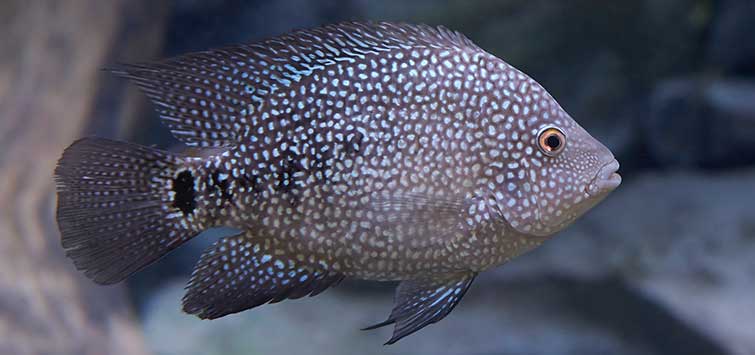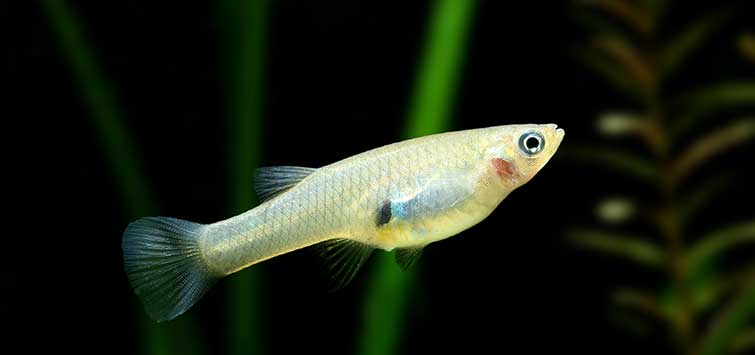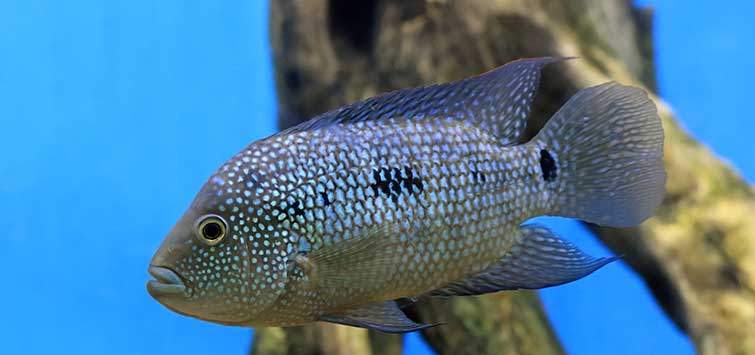The Texas Cichlid Herichthys cyanoguttatus
Author: William Berg
Big, bold, and beautiful—discover how to keep the only cichlid native to the United States.
Texas Cichlid Pride
The territorial Texas cichlid is the only cichlid native to the United States. Just like its Central American relatives, it can be quite aggressive and should only be kept by aquarists interested in dealing with belligerent fish.
The safest course of action is, of course, to keep the Texas cichlid on its own, but it can be combined with other hard-line species as long as the aquarium is at least 125 gallons. An aquarium of that size is also big enough to house a Texas cichlid pair, but be prepared to divide it into two sections if the couple turns out to be incompatible.
The natural home of the Texas cichlid is the lower Rio Grande Drainage in Texas and northeast Mexico, where it is a popular game fish. It can be found not only in the main river but also in smaller streams and pools, and is commonly referred to as the Rio Grande perch. It is known as mojarra del norte (northern mojarra) south of the river.
A Spirited Beauty
One of the reasons why Herichthys cyanoguttatus is such a popular aquarium fish is its appealing look. As a juvenile, the Texas cichlid is pearly gray with white dots on the body and fins and displays two characteristic black spots—one in the center of the body and the other at the caudal fin base. As it matures, the body develops a golden shade with pearly highlights, and the fins and body become adorned with white and turquoise spots.
The adult fish is also decorated with three black bars and the rear half of the body (including the caudal fin base) sports a profusion of small black dots. If you manage to get your fish into breeding mode in the aquarium, the underside of the body will turn black and the three black bars will become even darker than before.
Housing and Care
It is not advisable to house an adult Texas cichlid in an aquarium smaller than 75 gallons because it can reach a length of 12 inches. Try to mimic the natural habitat of the fish by covering the bottom of the aquarium with sand and providing lots of rocks and roots in the setup. Adding live plants will make the fish feel even more at home, but avoid sensitive species because the Texas cichlid is fond of burrowing near plants. An ideal setup would include rooted plants along with floating ones that dim the light and provide cover for the fish.
Herichthys cyanoguttatus is a subtropical species that will appreciate a water temperature of 70° to 75°F in the aquarium, but it is known to adapt well to both cooler and warmer conditions. The water should be basic, neutral, or just slightly acidic—pH 6.5 to 8.0. The recommended water hardness is dH 8 to 25.
Temperament and Tankmates
As mentioned above, the Texas cichlid is a feisty creature and should therefore only be combined with fish capable of fending for themselves. You can, for instance, keep it with aggressive Central and South American cichlids of roughly the same size, provided that your aquarium is large enough. It should also be noted that some specimens are exceedingly aggressive while others can be fairly non-confrontational toward other fish. Each fish has a unique personality that may change over time. Some specimens become virtually impossible to keep with any other fish as they age, and these individuals are best housed in their own aquarium.
Feeding
When it comes to feeding, the Texas cichlid is certainly not a finicky eater and will readily accept virtually any type of food, including flakes and pellets. Keeping H. cyanoguttatus on a diet that consists solely of dry food is not something I can recommend, however—in my experience, a Texas cichlid will stay much healthier and happier in the aquarium when provided a varied diet containing live (or at least fresh or frozen) foods. I prefer to use high-quality flakes and pellets as a base and supplement that with plenty of live and thawed meaty foods, such as worms and shrimps. I also include vegetables and algae-based food in the diet because even a fierce predator like the Texas cichlid ingests considerable amounts of green food in the wild.
Growing Your Own
Raising your own Texas cichlids is not very difficult once you have obtained a compatible pair, but unfortunately even mated Texas cichlids tend to fight each other a lot. Females can be distinguished by a black spot on their dorsal, which the males do not have. The male fish is generally larger and has brighter colors. Older males may develop a cranial bump, but some individuals never do despite their age, and there are also reports of female specimens with bumps.
Breeding
If you want to encourage breeding, provide your fish with a suitable flat surface that can serve as a breeding site, such as a flat stone. When the female is ready to breed (which typically happens when she has reached a length of 2 to 3 inches), she will start cleaning the breeding site. During the actual spawning she can deposit more than 1000 eggs, with each egg being about 2 mm in size.
Parenting
Texas cichlids are clutch tenders and both sexes are devoted parents. The male cichlid will guard the territory while the female cares for the eggs. Both sexes become extremely aggressive while tending to eggs and it might sound like a good idea to give them their own breeding aquarium, but I must advise against it. Without any other fish in the aquarium to take out his aggression on, the male fish may direct his violent behavior toward his partner and cause severe injury or even death. It is therefore better to keep the couple together with other fishes in a large and well-decorated aquarium with plenty of hiding spots. Another alternative is to use a divider to separate the male from the female and the eggs.
Fry
If you want to successfully raise a batch of Texas cichlids, it is imperative to keep the oxygen levels really high and the amount of organic waste low. The eggs will normally hatch within three to five days and the female will help her young ones emerge. The larvae will be transported to a pit that has been dug out in the sand and will be kept there for about five to eight days.
Free-swimming fry are normally big enough to devour newly hatched brine shrimp and powdered flakes, and they will eat organic matter in the aquarium as well. Don’t lose heart if the first few batches get eaten by the parents, as it is common for Texas cichlid couples to go through a few practice rounds before they get everything right.
Blues, Greens, and Reds
In the aquarium trade you can often find fishes sold under the names blue Texas cichlid, green Texas cichlid, and red Texas cichlid. These common names can cause quite a lot of confusion because they are used for color variants of Herichthys cyanoguttatus as well as for hybrids and entirely different species. Take the name blue Texas cichlid for instance—many pet shops use this name for a number of blue cichlids from North and Central America, including H. carpintis, H. cyanoguttatus, H. labridens, and others. The name blue Texas cichlid is also frequently applied to species that have not yet been scientifically described and given a proper scientific name, such as Herichthys sp. "Rio Cazones," Herichthys sp. "turquoise," and Herichthys sp. "Poza Rica."
The name green Texas cichlid is typically used for H. carpintis, a fairly close relative of H. cyanoguttatus, but it can also be used for other species and variants. H. carpintis is collected from Mexican waters, and it is unclear if it even exists in Texas. You can tell the two species apart by looking at the spots, as H. cyanoguttatus has smaller spots than H. carpintis. As mentioned above, H. carpintis is sometimes sold under the name blue Texas cichlid, which naturally makes the situation even more confusing for prospective cichlid owners. It is also known as the pearlscale cichlid and lowland cichlid.
The name red Texas cichlid is chiefly used for an aquarium hybrid between a Texas cichlid and some other cichlid. The ancestry of the red Texas cichlid is therefore obscure and variable. The quality of fry sold under the name red Texas cichlid or red flowerhorn varies a lot, and the number of specimens that develop into vibrantly red show cichlids will be really low even in a good batch. You can generally expect a significant portion of each batch to never become red at all, and black spotting is prevalent among those that do turn red. It is not uncommon for a “red” Texas cichlid to be more black than red.
Caretaking
A majority of the species, hybrids, and variants sold under the name Texas cichlid fortunately have fairly similar husbandry requirements and will appreciate roughly the same type of environment, diet, and care. They are also known to exhibit similar breeding behaviors. You may need to experiment a bit to find out exactly how to care for and breed your particular specimens, however. Also keep in mind that keeping possibly mislabelled fish with uncertain ancestry together will increase the risk of unwanted hybridization in the aquarium.
The fact that most fishes sold under the Texas cichlid flag are similar doesn’t mean that they are identical or only superficially different. H. carpintis will, for instance, rarely grow bigger than 8 inches while H. cyanoguttatus can reach a length of 12 inches, and this will naturally have a significant impact on recommended aquarium length and volume. You should also be prepared for temperamental differences. For example, the hybrid sold under the name red Texas cichlid is known to be even more violent than H. cyanoguttatus and is therefore more difficult to combine with other fish. On the other hand, H. carpintis is quite often kept in community aquariums with fish that exhibit medium levels of aggression.
A Great Group
The United States’ native cichlid and its relatives make great aquarium specimens, as long as the aquarium is quite large and its tankmates are appropriately sturdy. Largely unsung in its homeland until recently, Herichthys cyanoguttatus is quite popular in Europe. If you are into big, feisty cichlids, the Texas cichlid just might be for you!
See the full article on TFH Digital http://www.tfhdigital.com/tfh/201002/#pg79

.png?h=595&iar=0&w=2781&hash=5FD5E69473BCC22199FBFA2FB71B6033)



